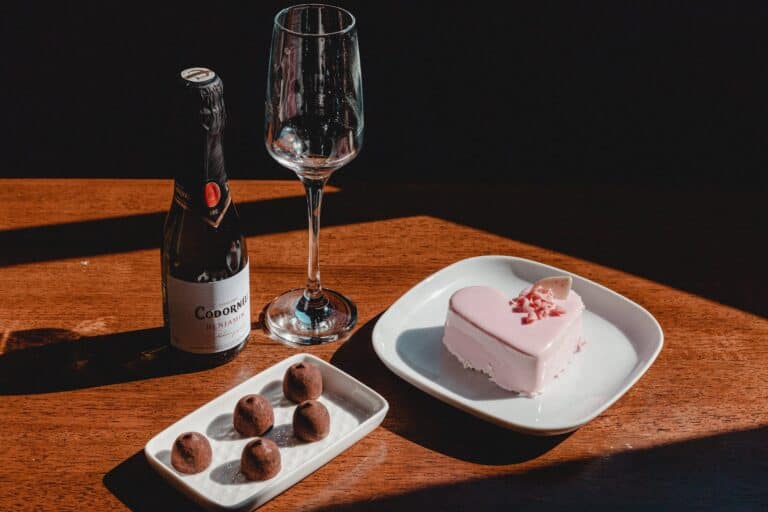Understanding Chocolate Varieties
Before diving into the intricacies of pairing, it’s essential to understand the fundamental characteristics of different chocolate varieties. Chocolate, derived from the cacao bean, can be broadly categorized into three main types: milk chocolate, dark chocolate, and white chocolate.

Types of Chocolate
- Milk Chocolate: Known for its smooth and creamy texture, milk chocolate contains a higher percentage of milk solids and sugar compared to dark chocolate. This results in a sweeter taste profile that complements lighter wines and enhances their fruitiness without overpowering their delicate flavors.
- Dark Chocolate: With a higher cocoa content and less sugar, dark chocolate offers a more intense and complex flavor profile. It ranges from bittersweet to semi-sweet, making it a versatile companion for a variety of wines, especially those with bold flavors and tannins like Cabernet Sauvignon or Zinfandel.
- White Chocolate: Despite not containing cocoa solids, white chocolate is primarily made from cocoa butter, giving it a rich and creamy texture. Its subtle sweetness pairs beautifully with fruity and floral white wines such as Moscato d’Asti or Riesling, creating a harmonious contrast that delights the palate.
Cocoa Butter
Beyond cocoa content, cocoa butter plays a crucial role in chocolate’s texture and mouthfeel. Its presence enhances the smoothness of milk and white chocolates, providing a luxurious experience that complements the effervescence of sparkling wines or the richness of dessert wines like Port or Ice wine.
Exploring Wine Varieties
Just as chocolate comes in different varieties, so too does wine offer a spectrum of flavors and aromas that can either complement or contrast with chocolate’s sweetness and bitterness. Understanding the characteristics of each wine type is key to creating perfect pairings that elevate the tasting experience.
Types of Wine

- Red Wines: Bold and full-bodied, red wines such as Cabernet Sauvignon, Pinot Noir, and Zinfandel are well-suited to dark chocolate pairings. Their robust tannins and deep fruit flavors provide a counterbalance to the bitterness of dark chocolate, enhancing its cocoa notes and creating a symphony of flavors on the palate.
- White Wines: Lighter and more delicate than their red counterparts, white wines encompass a range of styles from crisp Sauvignon Blanc to aromatic Chardonnay. White chocolate, with its creamy texture and mild sweetness, finds ideal companionship with these wines, accentuating their citrusy or floral undertones while offering a refreshing contrast.
Pairing Principles
Successfully pairing chocolate with wine hinges on understanding the interplay of flavors, textures, and aromas. Here are some essential principles to guide your journey through the delightful world of wine and chocolate tasting:
General Rules for Wine and Chocolate Pairing

- Balance Sweetness: One of the golden rules in wine and chocolate pairing is to match the sweetness levels. Sweeter wines like Moscato d’Asti or Ice Wine pair well with rich, sweet chocolates, enhancing the overall sweetness without overwhelming the palate. Conversely, dry wines such as Sauvignon Blanc or a robust red like Cabernet Sauvignon should be paired with darker, less sweet chocolates to balance the bitterness.
- Consider Tannins and Acidity: Tannins in wine can accentuate the bitterness in dark chocolate, so pairing high-tannin wines like Cabernet Sauvignon or Zinfandel with dark chocolate is ideal. On the other hand, wines with high acidity, such as a crisp Sauvignon Blanc, can cut through the creamy texture of milk and white chocolates, refreshing the palate with each bite.
- Enhance or Contrast Flavors: Think about whether you want to enhance the flavors of the chocolate or create a contrast. For example, pairing dark chocolate with a wine that has notes of black currant or dark berries can enhance the chocolate’s flavor profile. Meanwhile, pairing white chocolate with a wine that has apricot or citrus notes can create a delightful contrast, highlighting the chocolate’s creamy texture.
Enhancing the Experience with Texture and Flavor
- Texture Matters: The texture of the chocolate—whether it’s the creaminess of milk chocolate or the firm snap of dark chocolate—can affect the pairing. Creamy milk chocolates pair well with wines that have a smooth, velvety texture, like a demi-sec Champagne or a rich Tawny Port. Dark chocolates with their firm texture complement the bold structure of full-bodied reds and fortified wines.
- Exploring Complementary Flavors: Pay attention to the flavor profiles of both the chocolate and the wine. For instance, a milk chocolate with caramel notes pairs beautifully with a wine that has caramel or toffee undertones, such as a late harvest Riesling. Similarly, a dark chocolate with hints of coffee or spice is a great match for a robust red wine with a smoky or peppery finish.
Perfect Chocolate and Wine Combinations

Now that we have covered the basics, let’s dive into some exquisite pairings that exemplify the best of chocolate and wine together. Here are some top suggestions to kick things off:
Red Wine with Chocolate
- Cabernet Sauvignon and Dark Chocolate: The full-bodied nature of Cabernet Sauvignon, with its notes of black currant and oak, pairs exceptionally well with the intense bitterness of dark chocolate. This combination creates a rich, complex flavor profile that’s perfect for those who appreciate a bold taste.
- Pinot Noir and Milk Chocolate: For a lighter pairing, Pinot Noir’s bright acidity and red fruit flavors complement the creamy sweetness of milk chocolate. This match is perfect for those who enjoy a softer, fruitier wine experience.
- Zinfandel and Chocolate Covered Strawberries: The spicy, fruity notes of Zinfandel make it an excellent choice for chocolate-covered strawberries. The wine’s bold flavors enhance the sweetness of the strawberries and the chocolate, creating a delightful balance.
White Wine Pairings with Chocolate
- Sauvignon Blanc and White Chocolate: The zesty acidity and citrus notes of Sauvignon Blanc are a perfect match for the sweet, creamy texture of white chocolate. This pairing is refreshing and light, making it ideal for a summer dessert.
- Moscato d’Asti and White Chocolate: The sweetness and effervescence of Moscato d’Asti highlight the delicate flavors of white chocolate, creating a delightful contrast. This combination is especially enjoyable with white chocolate truffles or mousse.
- Late Harvest Riesling and Milk Chocolate: The honeyed sweetness and acidity of Late Harvest Riesling pair beautifully with the caramel and vanilla notes in milk chocolate. This combination is rich and indulgent, perfect for a cozy evening.
Dessert Wines and Chocolate Delights
- Port and Dark Chocolate: Ruby Port’s sweet, rich flavors and tannic structure make it an excellent partner for dark chocolate. The combination is a classic choice, offering a perfect balance of sweetness and bitterness.
- Ice Wine and White Chocolate: The intense sweetness and high acidity of Ice Wine create a beautiful balance with the smooth, creamy texture of white chocolate. This pairing is a true treat, highlighting the floral and fruity notes of both the wine and the chocolate.
Exploring Unusual Pairings
Sometimes, the most exciting pairings come from breaking the rules. Here are a few exceptions that might just surprise you:
- Rosé Port and Milk Chocolate: The delicate sweetness and berry notes of Rosé Port are a wonderful match for the creamy texture of milk chocolate. This pairing is unexpectedly delightful, offering a refreshing twist on traditional combinations.
- Champagne and Dark Chocolate: The crisp acidity and bubbles of Champagne create a refreshing contrast to the rich bitterness of dark chocolate. This pairing is elegant and sophisticated, perfect for special occasions.
Wrapping Up
Exploring the world of wine and chocolate tasting is a journey filled with rich flavors and delightful surprises. By understanding the characteristics of different chocolates and wines, you can create perfect chocolate and wine combinations that enhance each other’s unique qualities. Whether you’re enjoying a casual tasting at home or hosting a sophisticated wine and chocolate soirée, these pairings are sure to impress and delight your guests.
Remember, while there are general rules to guide you, the best wine and chocolate pairing is ultimately about personal taste and enjoyment. Don’t hesitate to experiment and find the combinations that make your palate sing. Cheers to the perfect blend of chocolate and wine!
Other suggested articles:
